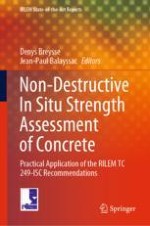2021 | OriginalPaper | Chapter
7. How Investigators Can Answer More Complex Questions About Assess Concrete Strength and Lessons to Draw from a Benchmark
Authors : Denys Breysse, Xavier Romão, Arlindo Gonçalves, Maitham Alwash, Jean Paul Balayssac, Samuele Biondi, Elena Candigliota, Leonardo Chiauzzi, David Corbett, Vincent Garnier, Michael Grantham, Oguz Gunes, Vincenza Anna Maria Luprano, Angelo Masi, Andrzej Moczko, Valerio Pfister, Katalin Szilagyi, André Valente Monteiro, Emilia Vasanelli
Published in: Non-Destructive In Situ Strength Assessment of Concrete
Publisher: Springer International Publishing
Activate our intelligent search to find suitable subject content or patents.
Select sections of text to find matching patents with Artificial Intelligence. powered by
Select sections of text to find additional relevant content using AI-assisted search. powered by
